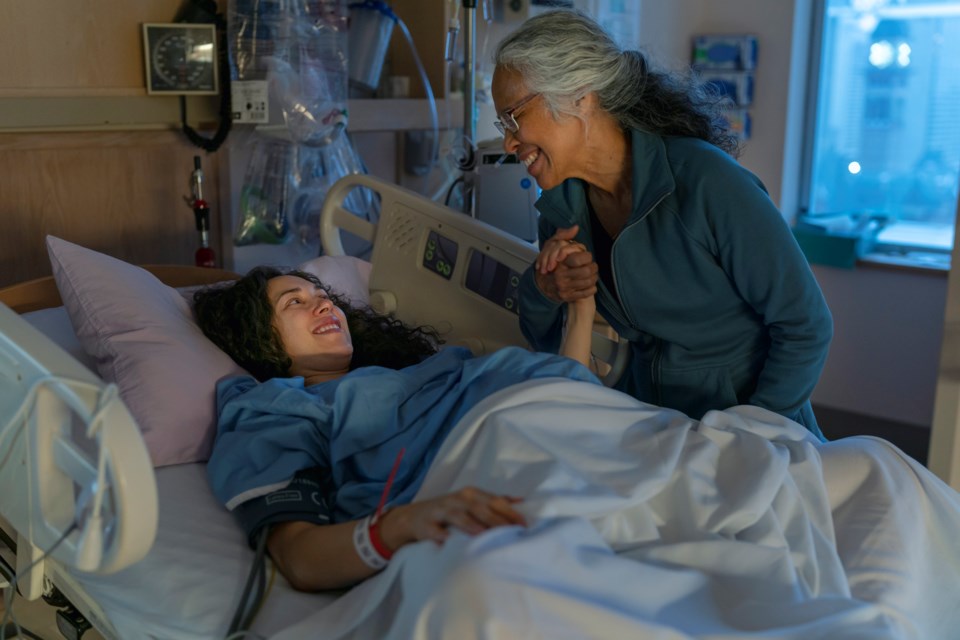As hospitalizations increase with another surge in COVID-19 cases, Canadians need evidence-based recommendations to prevent people from dying alone, without friends or family by their side.
It is important to learn from the last two years to improve and influence health-care visitation policies.
The pandemic has changed how people were able to support loved ones who were dying due to visitation restrictions and COVID-19 safety protocols.
From January to June 2021, we interviewed people who experienced a death of someone close to them during the pandemic. We wanted to deepen our understanding of people’s experiences during these unusual times of social isolation, masks and lockdowns so, as researchers and practitioners, we asked them to share their stories.
We heard about mothers, fathers, children, partners and friends dying in hospital, long-term care and at home alone — our research is yet to be published but will be shared in journals and at conferences.
We asked people what leaders and policy-makers need to understand so changes can be implemented to improve visitation and connection with those at end of life.
While participants in this research recognized the need for caution regarding infection control and reducing COVID-19 spread, there was a strong sentiment of needing to approach visitation and caregiver involvement differently.
Our health-care decision-makers need to understand the perspectives of those who didn’t get to say their final goodbyes.
Barriers to advocacy
Ongoing changes to visitation policies have made it difficult for many who want to be present when someone they know is seriously ill or dying. It is especially burdensome for individuals navigating existing barriers, such as language, cultural and other forms of discrimination.
In 2019, Canada’s chief public health officer recognized the detrimental effects discrimination and stigma can have on individuals accessing health-care services — this was evident from our interviews.
Some people indicated pre-existing barriers, including poor communication, which made advocacy for access and visitation overly burdensome. Others, primarily those with higher education or with privilege, were able to voice their concerns and successfully advocate for visitations, despite restrictions.
If people were able to advocate, sometimes visitation rules were flexible. This raises concerns for those who don’t have the ability to advocate for themselves. There’s a need for change.
Restriction disconnect
Restrictions were imposed in order to curb the spread of the virus. However, the rules didn’t always make sense to everyone.
The people we interviewed felt that restrictions within the health-care systems lacked rationale and transparency. They were frustrated that malls and restaurants remained open while they were unable to visit a seriously ill or dying person who mattered to them.
Some people argued that if they were to wear full PPE and follow precautions as health-care providers do, they shouldn’t be locked out.
Friends and family providing care for people in health-care settings argue they are essential members of the care team, offering expert, intimate knowledge and time.
One person told us they would spend hours at home encouraging their frail spouse to eat, but were only allowed to visit for one hour per week when their spouse was hospitalized. A mother was initially told she was unable to visit her seriously ill disabled son, but advocated to stay with him. As his daily caregiver and decision-maker, she understood his needs in a way health-care workers couldn’t.
While health-care systems continue to be put under pressure by new COVID-19 variants and critical staffing shortages, we argue that essential visitors need to include friends or family, particularly when a person is seriously ill or dying.
Changes need to be made
COVID-19 has altered the perspectives of many. Many health and social care providers are concerned that people who have been unable to say goodbye are at an increased likeliness of experiencing prolonged and complicated grief.
The pandemic has rendered caring, grief and connecting with loved ones at the end of life even more challenging than usual. But two years into the pandemic we are learning a hard lesson: connection and presence are essential.
Visitation restrictions are impacting our abilities to connect, care and love, which in turn will have a profound impact on grief and a wider social impact that we are only beginning to understand.
So, what can be done? We recommend:
- Make visitation for end of life a priority.
- When possible, allow more than one person at the bedside.
- Increase transparency of visitation policies by updating them regularly on facility websites and media.
- Enable technology (cellphones, iPads etc.) to allow more people to stay connected.
- Provide education and access to appropriate PPE and COVID-19 testing so visitation can be maintained in the safest way possible for all.
The findings from this research demonstrate that our health-care system needs to respond in a more just, inclusive, caring and timely way to allow in-person final goodbyes from those who matter most to those at the end of life.
As one person shared: “That is what COVID is doing to families, it’s robbing them being connected, and of grieving and of remembering and of just appreciating those gifts that those people were in our lives. And yeah, it’s just not right.”
![]()
Susan Cadell is affiliated with the NDP as a riding association member and former candidate.
Kathy Kortesm is affiliated with the Canadian Grief Alliance
Ashley Doyle and Sunita Lad do not work for, consult, own shares in or receive funding from any company or organisation that would benefit from this article, and have disclosed no relevant affiliations beyond their academic appointment.




